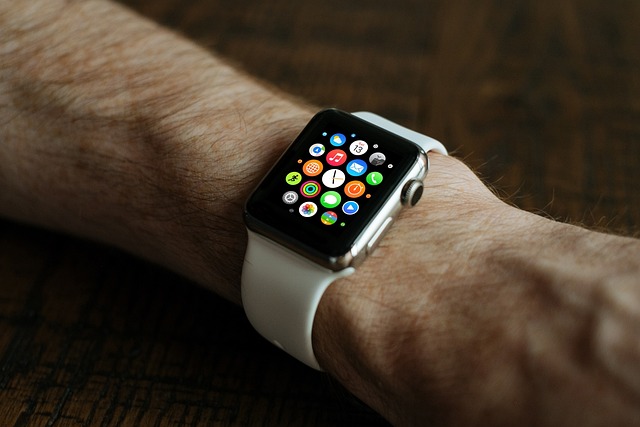If your Apple Watch is frequently needing recharging, a clear sign of reduced battery health, it might be time to consider replacing its battery. Over time, the battery's capacity can degrade, causing issues like longer charging times and less hold on charge. This deterioration not only affects convenience but also critical functionality and overall performance. Replacing the battery by a professional service is an effective solution to restore your watch's efficiency and extend its lifespan. Keeping the software updated can also help in optimizing battery life, but if these steps don't improve the situation, a battery replacement is the most definitive fix for ensuring your Apple Watch operates at its best. Signs of a degraded battery include a dimmer display, discoloration or streaks on the screen, and more frequent charging needs, which can all impact user experience and potentially lead to unexpected device shutdowns. Addressing these issues with a battery replacement will help maintain the watch's reliability and health, making it essential for those who rely on their Apple Watch for fitness tracking, notifications, and other daily functions.
When your Apple Watch’s performance wanes, it might be time to consider replacing its battery. This article outlines five clear indicators that signal the need for a fresh start with your device’s power source. From sluggish operation to frequent charging demands and visual anomalies, these signs are telltales of an aging battery. Recognizing these symptoms early can save you from complete functionality loss and ensure your Apple Watch continues to serve as a reliable companion on your wrist. Replacing an apple watch battery is not just about extending its lifespan; it’s about maintaining the precision and efficiency that define the Apple Watch experience.
- Recognizing the Need for a New Battery in Your Apple Watch
- Sluggish Performance Indicates Battery Wear in Your Apple Watch
- Frequent Charging Needs Point to a Drained Apple Watch Battery
- Visual Cues and Display Issues with an Aging Apple Watch Battery
- Unresponsive Touchscreen Suggests It's Time to Replace Your Apple Watch Battery
Recognizing the Need for a New Battery in Your Apple Watch

When your Apple Watch’s performance starts to wane, it may be a sign that the battery is nearing its useful life and replacement is imminent. A consistent need for frequent charging, particularly if your watch is new or only a few years old and wasn’t previously prone to rapid depletion, is a clear indication that the battery might require professional attention. The Apple Watch is designed with efficiency in mind, but over time, its ability to hold a charge can diminish. If you notice that the charging icon stays on your watch face longer than usual or it doesn’t hold a charge for the expected duration, these are telltale signs that it’s time to consider replacing the battery. Opting for a battery replacement service from authorized Apple service providers or reputable third-party technicians can restore your watch’s longevity and performance without the need for a full device replacement. Regular software updates can also optimize your watch’s battery life, but if these adjustments don’t alleviate the issue, replacing the battery is likely the best course of action to ensure your Apple Watch continues to function at its best.
Sluggish Performance Indicates Battery Wear in Your Apple Watch

When your Apple Watch begins to drag or lag during daily use, it might be a sign that its battery is on its last legs. Over time, consistent charging and discharging can lead to degraded battery performance. This sluggishness isn’t just an inconvenience; it’s a clear indicator that it may be time to replace the Apple Watch battery. As the power source of your device, the battery is integral to its functionality. A diminished battery will not only affect the responsiveness of your watch but can also cause it to fail during critical operations. To maintain optimal performance and ensure your Apple Watch functions reliably, considering a battery replacement is a prudent step. It’s advisable to address this issue promptly because a watch that performs sluggishly now may become unresponsive soon, leaving you without the timely notifications and seamless interaction that an Apple Watch provides. Seeking a professional service to replace the battery can restore your device’s efficiency and extend its lifespan, making it a cost-effective solution compared to a full replacement of the watch.
Frequent Charging Needs Point to a Drained Apple Watch Battery

If your Apple Watch is consistently requiring frequent charging sessions, it may be an indicator that its battery is reaching the end of its lifespan. Over time, lithium-ion batteries in electronic devices, including the Apple Watch, can degrade and hold less charge than they once did. This situation not only impedes the convenience of using your watch but also affects its functionality. A notable decrease in battery longevity between charges is a clear sign that it’s time to consider replacing the battery. This simple maintenance service can restore your Apple Watch to its optimal performance, ensuring you can track your health and fitness data with the confidence that your device won’t run out of power at an inconvenient moment. When faced with this common issue, opting for a professional battery replacement service is a prudent step to revitalize your watch’s efficiency and longevity.
Visual Cues and Display Issues with an Aging Apple Watch Battery

When it comes to assessing the health of an Apple Watch, visual cues and display issues can be telling signs that your device’s battery may have reached its twilight years. As the battery within an Apple Watch ages, it can begin to exhibit subtle yet significant changes in its performance and appearance. One of the most noticeable signs is a reduction in screen brightness or an increase in dimming too quickly, even when adjustments are made. This can render the display less legible, particularly under bright lighting conditions or during outdoor activities. Another indicator is the presence of visual anomalies on the screen, such as discoloration, streaks, or patches that do not align with normal operation, which may suggest a weak battery affecting the display’s functionality. Such issues can impact the user experience significantly and are compelling reasons to consider replacing the Apple Watch battery.
Battery degradation can also manifest through inconsistent power levels, with the watch struggling to hold a charge as effectively as before. You might find yourself charging your Apple Watch more frequently, or that it discharges faster than usual. These patterns can be frustrating and indicate that the battery’s capacity is diminishing. It’s important to address these signs promptly since a failing battery not only affects usability but can also lead to unexpected shutdowns or data loss. Replacing the Apple Watch battery is a straightforward solution that can restore the device’s performance and longevity, ensuring that your smartwatch continues to serve as a reliable companion for years to come.
Unresponsive Touchscreen Suggests It's Time to Replace Your Apple Watch Battery

When a beloved Apple Watch begins to show signs of aging, it’s often a clear indication that replacing its battery is in order. If you’ve noticed your device’s performance slowing, charging more frequently than usual, displaying visual cues such as a dim or flickering screen, or becoming unresponsive to touch, these are telling signals that it’s time to replace the Apple Watch battery. Regular maintenance through timely replacements ensures your watch maintains its precision and reliability, allowing you to continue relying on it for accurate timekeeping and valuable health insights. Remember, replacing an Apple Watch battery can restore your device’s functionality, making it a worthwhile investment for any tech enthusiast or daily user.
